-
Countries
-
Data and Analysis
-
Special Focus
-
Crisis Responses
Return migration
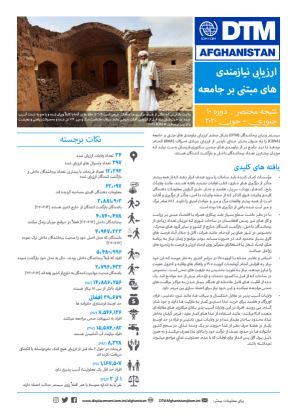
Contact
DTMAfghanistan@iom.int
Language
Dari
Location
Afghanistan
Period Covered
Jan 01 2020
Jun 30 2020
Activity
- Mobility Tracking
- Site Assessment
سیستم ردیابی بیجاشدگان (DTM) در ماه جون سال ۲۰۲۰ ارزیابی نیازمندی های مبتنی بر جامعه (CBNA) را به عنوان بخش جدایی ناپذیر از ارزیابی بنیادی تحرکات (BMA) در سطح قریجات آنجام داد تا دید جامع تر از نیازمندی های چندین سکتوری قریجاتی بدست بیاید که میزبان بیشترین تعداد بیجاشدگان داخلی و بازگشت کنندگان هستند.

Contact
dtmzimbabwe@iom.int
Language
English
Location
Zimbabwe
Period Covered
Feb 24 2021
Apr 14 2021
Activity
- Return Intention
Tropical Cyclone Idai made landfall in Zimbabwe on 15 March 2019 and the country experienced floods and sustained heavy rains. From the 24th of February to the 5th of March 2021 and from the 8th to the 14th of April 2021, IOM, in partnership and close coordination with the Government of Zimbabwe, conducted DTM return intention assessments in all the wards of Buhera, Chimanimani and Chipinge districts of Manicaland province in Zimbabwe. This exercise collected data from a total of 2,167 IDP households (HH) in all the 3 districts combined. The following report is an analysis of the data gathered from the assessment, covering household profiles, intentions, and livelihood situations. The main objective of the survey is to better understand the intentions and living conditions of the population residing in these affected areas to support recovery and reintegration efforts by providing the support needed in terms of shelter and livelihoods. An electronic questionnaire was used to collect the data and simple random sampling was used as the sample selection method for the respondents. Analysis of the data has been done using descriptive statistics and visualisation techniques. While our approach was in-person administration of questionnaires, a few respondents could not be reached in person as they were not present at their homesteads. However, the results of the study cannot be generalized to a larger population and are indicative of trends and patterns only as the sample is not representative of the entire IDP population in the 3 districts.

Contact
DTMsupport@iom.int
Language
Spanish
Location
Guatemala
Period Covered
Aug 12 2020
Sep 08 2020
Activity
- Survey
- Flow Monitoring Survey
Distintos gobiernos alrededor del mundo han implementado una serie de medidas para afrontar los retos que presenta la pandemia del COVID-19 e intentar dar protección a las poblaciones más vulnerables. Uno de los grupos que se ve particularmente afectado es el de las personas migrantes, como lo menciona el Director General de la OIM, António Vitorino: “Cuando los migrantes y las comunidades desplazadas son excluidas de los planes y servicios de respuesta nacional, en particular en lo relacionado con la atención sanitaria, todos terminan estando en una situación de riesgo agravado”. El Gobierno de Guatemala declaró estado de calamidad en todo el territorio al pasado 5 de marzo, ante la pandemia por COVID-19. Más de 17,750 personas guatemaltecas han sido retornadas desde México (54%) y Estados Unidos (46%) a Guatemala, en el período comprendido desde el 1 de marzo al 30 de septiembre de 2020. Las medidas tomadas por el gobierno ante la pandemia del COVID-19 establecen una cuarentena por aproximadamente 4 días para toda persona migrante que regrese al país, medida vigente durante el período de levantamiento de información en 5 albergues temporales donde las personas pueden obtener servicios médicos, de alimentación, higiene, entre otros, gracias a distintos esfuerzos de instituciones públicas y privadas. Una vez la persona ha cumplido su período de cuarentena, es transportada hacia su comunidad de origen, con el apoyo de la Organización Internacional para las Migraciones (OIM). No obstante, este escenario plantea otros retos relacionados a las condiciones y necesidades de la población a corto y mediano plazo, tal como lo reafirma Vitorino: “También necesitamos anticiparnos y prepararnos para las consecuencias económicas potencialmente graves sobre los migrantes, los países de origen y los de acogida”. Como parte de la respuesta interagencial del Equipo de País de Naciones Unidas y en coordinación con el Instituto Guatemalteco de Migración (IGM), la OIM, con el apoyo de distintos proyectos y donantes, ha entregado, a cada persona retornada que cumple con el periodo establecido por las autoridades, una despensa familiar que incluye diversos artículos. Sin embargo, es claro que esto no es suficiente y que el desarrollo de programas de apoyo a la restitución de sus medios de vida es fundamental para lograr una reintegración que garantice el desarrollo humano. Ante esto, la OIM presenta al gobierno de Guatemala y sus contrapartes el reporte preliminar de la Encuesta de Medios de Vida con el objetivo de generar información para el desarrollo de programas de apoyo para la reintegración de las personas migrantes y sus familias.
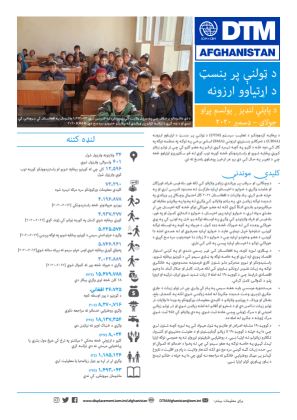
Contact
DTMAfghanistan@iom.int
Language
Pashto
Location
Afghanistan
Period Covered
Jul 01 2020
Dec 31 2020
Activity
- Mobility Tracking
- Site Assessment
د بېځایه کېدوونکو د تعقیب سیسټم (DTM) د ټولنې پر بنسټ د اړتیاوو ارزونه (CBNA) د تحرکاتو بنسټیزې ارزونې (BMA) اساسي برخې په توګه د ۲۰۲۰ کال په ډسمبر میاشتې کې د کلیو په کچه ترسره کړه ترڅو په هغو کلیو کې چې تر ټولو زیاتو کورني بېځایه شویو او راستنېدونکو څخه کوربه توب کوي له څو سکټوریزو اړتیاوو څخه چې د تغییر په حال کې دي یو هر اړخیز پوهاوی رامنځ ته شي.
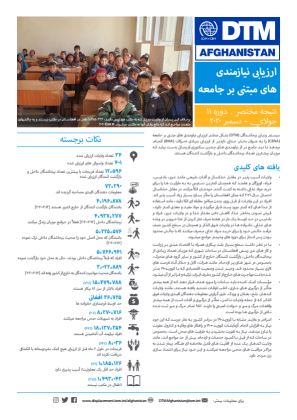
Contact
DTMAfghanistan@iom.int
Language
Dari
Location
Afghanistan
Period Covered
Jul 01 2020
Dec 31 2020
Activity
- Mobility Tracking
- Site Assessment
سیستم ردیابی بیجاشدگان (DTM) در دسمبر سال ۲۰۲۰ ارزیابی نیازمندی های مبتنی بر جامعه (CBNA) را به عنوان بخش جدایی ناپذیر از ارزیابی بنیادی تحرکات (BMA) در سطح قریجات آنجام داد تا دید جامع تر از نیازمندی های چندین سکتوری قریجاتی بدست بیاید که میزبان بیشترین تعداد بیجاشدگان داخلی و بازگشت کنندگان هستند.
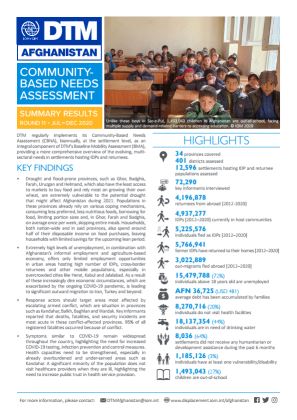
Contact
DTMAfghanistan@iom.int
Language
English
Location
Afghanistan
Period Covered
Jul 01 2020
Dec 31 2020
Activity
- Mobility Tracking
- Site Assessment
In January through December 2020, DTM implemented the Community-Based Needs Assessment (CBNA) at the settlement level, as an integral component of DTM's Baseline Mobility Assessment (BMA), providing a comprehensive overview of the evolving, multi-sectoral needs in settlements hosting IDPs and returnees.
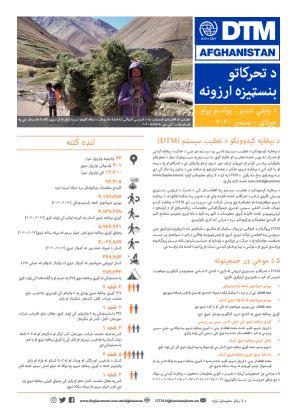
Contact
DTMAfghanistan@iom.int
Language
Pashto
Location
Afghanistan
Period Covered
Jul 01 2020
Dec 31 2020
Activity
- Mobility Tracking
- Baseline Assessment
د بېځایه کېدونکوو د تعقیب سیسټم په افغانستان کې د تحرک د ارزونې بنسټیزې وسیلې کاروي ترڅو له تحرکاتو څخه څارنه وشي او د نفوس په هکله اټکلونه، د جبري بېځایه کېدنو موقعیتونه او جغرافیه وي وېش څرګند شي. سربېره پر دې DTM د بېځایه کېدو مهال، علت، اصلی سیمې، لومړني جمعیتی معلومات، زیانمنتیاوې او د اړتیاوو د لومړیتوبونو څخه څارنه کوي. معلومات د کلیو په کچه کلیدي معلوماتو ورکوونکو سره د ډله ایز بحثونو او مخامخ کتنو له لارې راټولېږي.
د ۲۰۲۰ کال ډسمبر ۳۱ پر بنسټ په ۳۴ ولایاتو کې ۴۰۱ ولسوالی او ۱۲٬۶۰۰ کلي د ۷۲٬۳۰۵ کلیدي معلومات ورکوونکو سره د مرکې له لارې ارزول شوي دي. له ۲۰۱۲ کال څخه د ۲۰۲۰ کال ډسمبر میاشتې پورې ۴٬۱۹۶٬۸۷۸ راستنېدونکي و ۴٬۹۳۷٬۲۷۷ کورني بېځایه شوي چې اوسمهال په کوربه ټولنو کې اوسېږي پېژندل شوي دي.

Contact
DTMAfghanistan@iom.int
Language
Dari
Location
Afghanistan
Period Covered
Jul 01 2020
Dec 31 2020
Activity
- Mobility Tracking
- Baseline Assessment
DTM در افغانستان از ابـزار ارزیـابی بنیـادی تحـرکات اسـتفاده میکنـد تا تحـرکات ردیابی گردیده معلومات در مورد تخمین مـیزان نفوس، موقعیـت و تقسیمات جغرافیایی جمعیت های بیجا شده اجباری، بازگشت کننده و مهاجر آماده گردد. علاوه بر این DTM دلایـل و زمان بیجاشدگی و محل اصـلی بیجاشدگان را بشمول آمار گیری اسـاسی در مـورد جمعیـت، سـطح آسـیب پذیـری و نیازمندی های اولیه آنان را ردیابی مینماید. اطلاعات از طریـق بحـث هـای گروهی اجتماعی بـا معلومـات دهنـدگان کلیـدی، و مشـاهدات مسـتقیم به سطح قریجات جمع آوری میشـود.
طبق ۳۱ دسمبر سال ۲۰۲۰، ۳۴ ولایت، ۴۰۱ ولسوالی و ۱۲٬۶۰۰ قریه از طریق مصاحبه با ۷۲٬۳۰۵ معلومات دهندگان کلیدی ارزیابی گردیده اند. از سال ۲۰۱۲ الی دسمبر ۲۰۲۰ به تعداد ۴٬۱۹۶٬۸۷۸ بازگشت کننده خارج از کشور و ۴٬۹۳۷٬۲۷۷ بیجاشده داخلی که در حال حاضر در جوامع میزبان زندگی میکنند شناسایی گردیده اند.

Contact
DTMAfghanistan@iom.int
Language
English
Location
Afghanistan
Period Covered
Jul 01 2020
Dec 31 2020
Activity
- Mobility Tracking
- Baseline Assessment
In Afghanistan, DTM employs the Baseline Mobility Assessment tool, designed to track mobility, determine the population sizes, locations and geographic distribution of forcibly displaced, return and migrant populations, reasons for displacement, places of origin, and times of displacement, as well as basic demographics, vulnerabilities and priority needs. Data is collected at the settlement level, through community focus group discussions with key informants and direct observations.
As of 31 December 2020, 34 provinces, 401 districts and 12,600 settlements have been assessed, including interviews with 72,305 key informants. Between 2012 and December 2020, 4,196,878 returnees and 4,937,277 IDPs currently living in host communities were identified.

Contact
Regional Office Dakar, RODakar-DataResearch@iom.int
Language
English
Activity
- Other
- Survey
- Flow Monitoring Survey
- Return Intention
- Registration
- Flow Monitoring
- Migrants presence
- Mobility Tracking
- Baseline Assessment
- Points of Entry (PoE)
- Event Tracking
- Site Assessment
Migration is an integral part of life in West and Central Africa, a long tradition embedded in its historical, economic, social and cultural fabric. The region is a pivotal area of mobility, home to strong intraregional migration and, thanks to its strategic location at the crossroads, close exchanges with other regions.This first edition of the “A Region on the Move” report provides an overview of population movement trends in West and Central Africa in 2020. It aims to provide a comprehensive overview of mobility in the region and showcase the versatility, multidimensionality and nuances of regional mobility in West and Central Africa.
To that end, the report presents regional mobility using two broad strokes:
- Internal forced displacement: the report provides a detailed analysis of regional displacement numbers, trends and events in 2020, focussing on the five primary security crises affecting West and Central Africa (the Lake Chad Basin Crisis, the Central Sahel Crisis, the Central African Republic Crisis, Nigeria’s North West & North Central Crisis and Cameroons’ Anglophone Crisis)
- Migration flows: the report provides a study of regional migration flows in West and Central Africa. This section makes a distinction between intraregional (internal to West and Central Africa) and inter-regional (with a focus on movements between West and Central Africa and North Africa and Europe) mobility: in each of these sections, the report examines the primary mobility trends and events observed in 2020 as well as the profiles of mobile populations.
The 2020 edition of the report also explores the impacts of the COVID-19 crisis on mobility (including forced displacement and migration flows) and examines the health, socioeconomic, protection and impacts of the COVID-19 pandemic on mobile populations.
The analysis builds on multiple data sources, most of them directly managed and collected by IOM, with external sources used to further complement the mobility picture and provide a holistic understanding of population movement dynamics in West and Central Africa. IOM’s Displacement Tracking Matrix (DTM), which monitors internal forced displacements, migration flows, and characteristics of populations on the move constitutes the main data source for the report.
Pagination
- Previous page
- Page 20
- Next page
